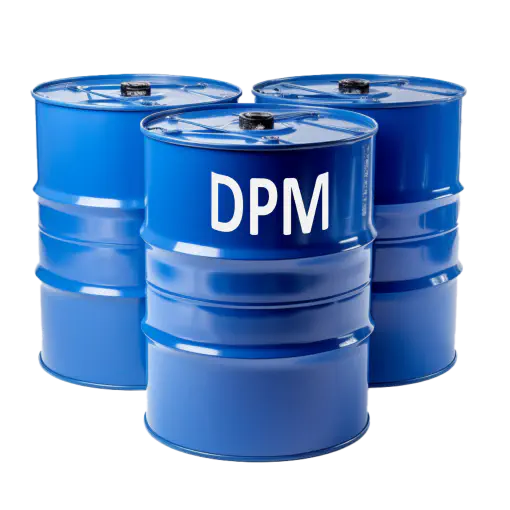DPM (Dipropylene glycol methyl ether), also known as methyl diglycol, is a commonly used industrial solvent that offers several desirable physical features. Here are some of the physical features of DPM:
Characteristics
-
Appearance:
DPM is a clear, colorless liquid with a mild, ether-like odor.
-
Viscosity:
DPM has a relatively low viscosity, which means it flows easily. This makes it suitable for applications where good solvency and spreading properties are required.
-
Boiling Point:
The boiling point of DPM is approximately 190-198 degrees Celsius, which is relatively high for a solvent. This high boiling point makes DPM useful in high-temperature processes and applications.
-
Density:
The density of DPM is around 0.95 grams per cubic centimeter (g/cm³), which is slightly higher than water. It is considered to be a relatively dense solvent.
-
Polar Nature:
DPM is a polar solvent, meaning it has dipole-dipole interactions and can dissolve polar compounds. Its polar nature allows it to solvate a wide range of substances, including many resins, dyes, and oils.
-
Miscibility:
DPM is miscible (ability to mix in all proportions) with several common organic solvents such as alcohols, ketones, and glycol ethers. It exhibits limited solubility in water.
-
Evaporation Rate:
DPM has a moderate evaporation rate, which means it evaporates not too quickly and not too slowly. This property makes it suitable for applications where controlled evaporation is desired.
-
Low Volatility:
DPM has relatively low volatility, meaning it has a low tendency to vaporize into the air at room temperature. This low volatility contributes to reduced odor and controlled release of the solvent during use.
-
Stability:
DPM is chemically stable under normal conditions. It is resistant to oxidation and does not readily react with common chemicals. This stability allows for a longer shelf life and ease of handling.
-
Low Emissions:
DPM is considered to have low emissions of volatile organic compounds (VOCs), making it a suitable choice for applications where environmental and air-quality regulations are a concern.
These physical features of DPM make it a versatile solvent in several industrial applications, including coatings, printing inks, cleaning solutions, and as a coupling agent in various formulations.
Applications
DPM (Dipropylene glycol methyl ether), commonly referred to as methyl diglycol, is widely used in various industrial applications as a solvent. Here are some examples of its industrial uses:
-
Coatings and Paints:
DPM is commonly used as a solvent in the formulation of coatings and paints. It helps dissolve and disperse various resins, pigments, and additives, improving the viscosity, flow properties, and overall performance of the coating or paint. DPM also aids in controlling drying time and enhances film formation.
-
Printing Inks:
DPM is utilized as a solvent in the production of various printing inks, including flexographic, gravure, and screen inks. It helps dissolve the ink components, ensuring good flow and spreading properties during the printing process.
-
Industrial Cleaning Products:
Due to its excellent solvency and low volatility, DPM is used in industrial cleaning formulations such as degreasers, paint strippers, and adhesive removers. It effectively removes oils, grease, dirt, and various contaminants from surfaces.
-
Electronics and Semiconductors:
DPM is employed as a cleaner and solvent in the electronics and semiconductor industries. It is used for cleaning printed circuit boards (PCBs), removing flux residues and contaminants. DPM is also suitable for thinning and cleaning semiconductor coatings and photoresists.
-
Adhesives and Sealants:
DPM is utilized as a solvent in the formulation of adhesives and sealants. It helps dissolve the adhesive components, providing good viscosity, flow properties, and adhesion. DPM is also used as a coupling agent, improving the compatibility between different adhesive components.
-
Chemical Reactions and Intermediates:
DPM can serve as a reaction solvent or as an intermediate in various chemical processes. It is often employed in the production of pharmaceuticals, plasticizers, and specialty chemicals.
-
Personal Care and Cosmetics:
DPM can be found as an ingredient in personal care and cosmetic products. It is used to solubilize, stabilize, or enhance the performance of certain active ingredients, fragrances, and preservatives.
-
Manufacturing and Industrial Processes:
DPM finds applications in manufacturing processes such as metal cleaning and degreasing, as well as in formulation of metalworking fluids, where it aids in lubrication and cooling.
These are just a few examples of the industrial uses of DPM solvents. Its solvency, low volatility, and stability make it a valuable solvent in various industries and applications. It’s important to note that DPM should be used as directed for each specific application to ensure safety and effectiveness.
